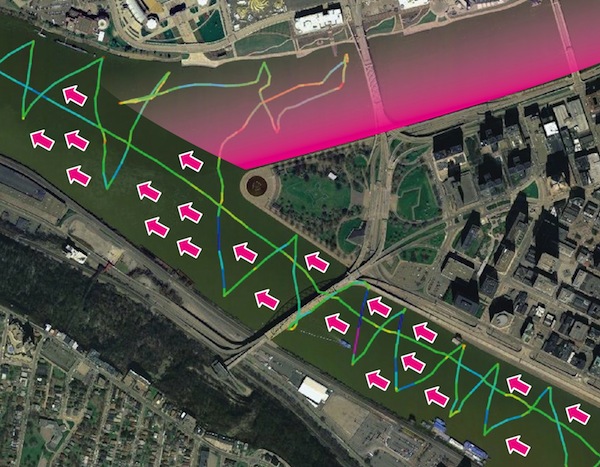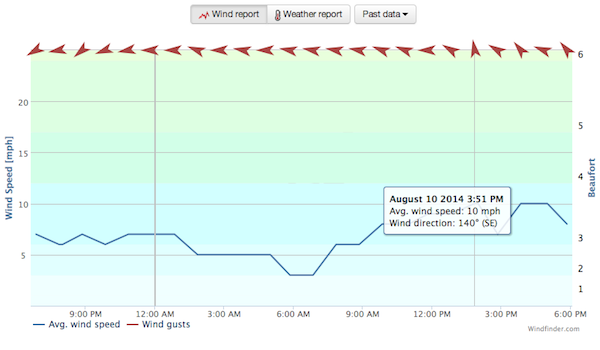Perfect Weather, Perfect Sailing
August 10, 2014
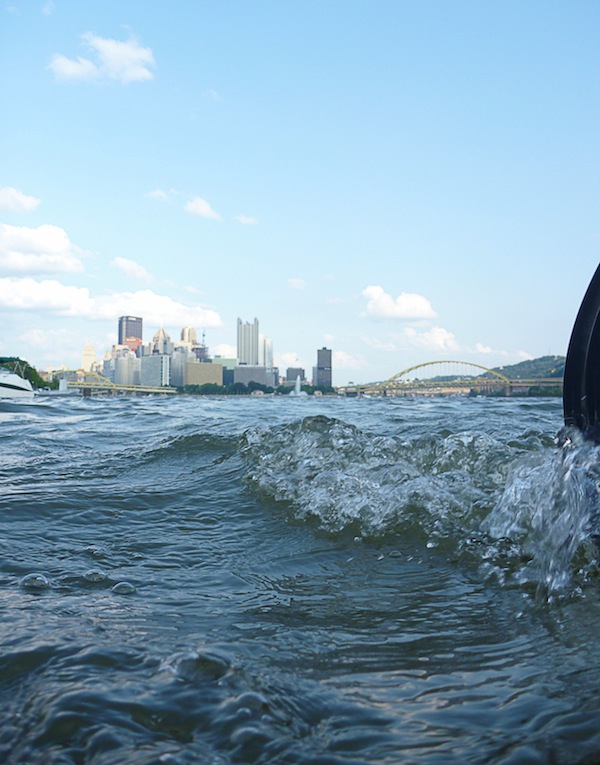
This was not a day on which I had planned to sail. In the morning, I'd had a three mile warm up run and then an hour plus in the gym with a trainer. After that, on this sleepy Sunday morning, I had earned a rest. Or so I thought.
Over a late breakfast, I couldn't help but notice that all the conditions were aligning for a perfect day of sailing. The winds were forecast to be a steady 10 mph from the Southeast. Those winds would blow perfectly along the Mon and Ohio Rivers. They would give me good steady winds in which to sail. The wind speed is just right. Once the wind blows harder than 10 mph, my little Hobie Bravo is overpowered and can be hard to tack, as I've reported elsewhere. Less than 10 mph, is very pleasant but it can be leisurely.
Here's the forecast I saw:
The catch is that Southeasterly winds blow with the current. That can be troublesome if the winds are not strong, as explained here. But they are strong today. Better, the currents are finally dropping after being higher than normal through most of the summer. The crucial number for me, the flow on the Ohio, was down to 16,500 cubic feet per second, which is slow enough for me to beat.
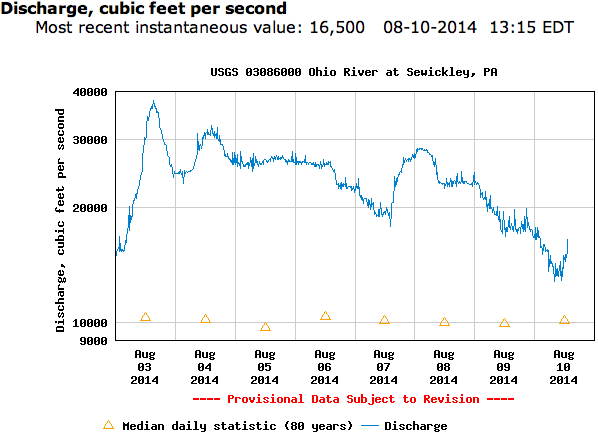
(Here are the flows on the Allegheny and Mon; and here is the flow on the Ohio taken a few hours later. The little jump in the chart above proved enduring.)
Finally the temperature forecast is pleasant, in the low 80s F. It's a little warmer than I'd like. If there's wind, as there will be today, those breezes will keep me cool. If the winds drops, however, then I will cook.
River sailing is fickle and it's best to sail whenever the conditions are right, even if you hadn't planned it for that day. I hopped on my bicycle for the 2.5 mile ride to the marina. On the Seventh Street Bridge I paused to check the wind. It was blowing strongly at roughly 10 mph from the East. If that held, I'd be able to sail up the Allegheny. (Spoiler: it didn't.) I did marvel at the view from the bridge into the ball field where a game was underway.
On arriving at the Newport Marina, I made my way to the end of the dock. It's always my first concern. I know what flow is reported for the river, but what will I see?! I threw a stick into the river and watched how the current moved it. It was merely a lazy drift. Good.
I held up my wind gauge to measure the wind speed. It was blowing at around 4 mph from the Point. If that wind held steady, it would be enough to beat the meager current. But it was less than the 10 mph forecast. Perhaps there would be better wind out in the middle of the river?
At 3:30pm, I put into the river. There was a stronger, steady wind after all. It had to be more than 5 mph since the gps tracks were showing my boat at sustained speeds of 4-5 mph, while I tacked close hauled into the wind.
That meant that I had little trouble making it upstream to the Point. It was probably the fastest progress to the Point I can recall for a Southeasterly wind, which meant that I had to sail into the wind to get to the Point.
Here I am at the submarine and Science Center.
One of things you take for granted in Pittsburgh is that its industrial grit will suddenly pop up to surprise you. Here I am enjoying the wind and water and then, on the Southern bank of the river, is the powerful, loud rumble of a locomotive.
By 4pm I was pretty much at the Point.
I tried turning up the Allegheny River. I wanted to get to the cluster of activity around the ballpark, where a game was underway. I wasn't sure that it was possible. All the indicators were that the wind was blowing steadily from the Southeast. That was visible in the plume of the fountain at the Point...
...and in the flag on Heinz Field.
I tried. But now I was sailing in waters with air that was sometimes calm and sometimes carried brief gusts of wind from unexpected directions. I made it as far as the Fort Duquesne Bridge before deciding, at 4:20pm, that it wasn't worth the effort of struggling with erratic winds. Good winds were likely on the Mon.
So I turned my bows downstream and slowly worked my way to the Point. Here I am approaching the Point in unsteady winds. I can see in the plume at the Point that, there, the winds are strong.
Afterwards, in looking at the gps plot, the wind shadow cast by the Point is quite clear. I could reconstruct the true wind direction at the water's surface from the angles of my tacks and the edge of the wind shadow. It was blowing more East South East. The arrows show the wind direction and the wind shadow is the colored block.
On rounding the Point, the great sailing returned. I quickly picked up the steady winds on the Mon, blowing as expected downstream. I tacked to and fro, advancing slowing up the river.
Looking back to the Point:
Approaching the Fort Pitt Bridge:
The Fort Pitt Bridge is passed:
I'm getting strong winds on this section of the Mon.
This was the best sailing. On one tack, the winds picked up enough for me to "fly a hull." The force of the wind is so strong that I had to throw my body out over the edge of the deck to balance the boat. Looking down at the hull on my side, I could see that it had risen out of the water and was, from moment to moment, touching the water surface and kicking up little spurts of white spray.
When you fly a hull, the resistance of the boat in the water is greatly reduced. There's only one hull cutting through the water instead of two. So here I managed some of the fastest speeds I've ever managed with the Hobie Bravo. This little spurt was 8.3 mph. It is the purple stretch in the portion of the gps track shown below.
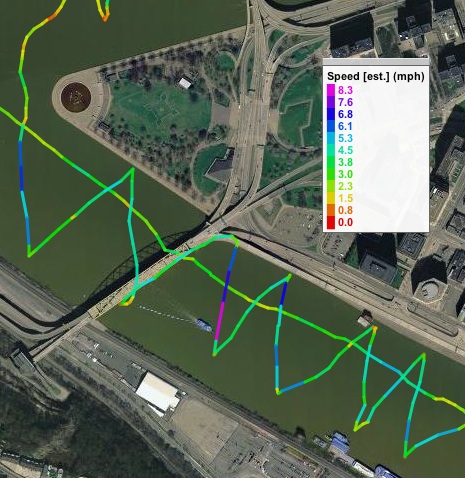
This is a busy section of the river. There are plenty of river boats coming and going.
It is where they are docked.
There's Ducky tours.
They also launch here.
I proceeded up the Mon and passed the Smithfield Street Bridge.
This stretch of the rivers has is own special character. It is no longer in the "no wake" zone of the Point. So big power boats can speed through kicking up huge (to me) wakes. Since the portion of the river is quite confined, the waves trapped and bounce back and forth like in an echo chamber.
Many power boaters are thoughtful and try not to overwhelm me with their wakes. Some, I must presume, are just unaware of the havoc their wakes cause small boats. And some, I am guessing, think that hurling a giant wake at me is some sort of expression of their dominance and power. To me, however, it just says that a little man can open a throttle and make a big wave. There's no careful gauging of the wind and setting the sails perfectly to match. There's no subtlety or artistry. There's no challenge and no achievement.
Now and again I found myself trapped in confusing waves raised by the wakes of multiple boats, echoing about.
At 5:15pm, it felt like I'd sailed enough. I was tired and a little sore. The deck is hard and unforgiving. So I turned my bows for home. I would now sail on a run; that is, with the wind behind me. This is the least interesting point of sail. I reefed the sail a little (i.e. partially rolled it up), since it otherwise tends to fold over onto itself.
When you sail into the wind, you feel the wind and magnify it by your own motion. When you sail with the wind on a run, your motion cancels out the wind. So I expected the air now to be calmer on deck. However it seemed too calm. I wondered if perhaps the wind a dropped.
Later, checking the wind reports, there seems to have been no drop. Both showed steady winds from the Southeast or East South East or even East, in the 8-10 mph range.
Here's the National Weather Service records.

Here I am passing an enormous coal barge. It's hard to see since I had to photograph into the light.
My wake as I leave downtown and the Point behind:

After a little over half an hour, I sailed into the lagoon at the marina (at 5:50).
It has been a splendid day. The winds on the Ohio and Mon Rivers had been steady and strong. They were in just the range I like (around 10 mph). The sky was blue and the air was warm. There were plenty of other boats on river, so there was plenty of navigating to be done. That keeps the sailing interesting.
John D. Norton
Back to main

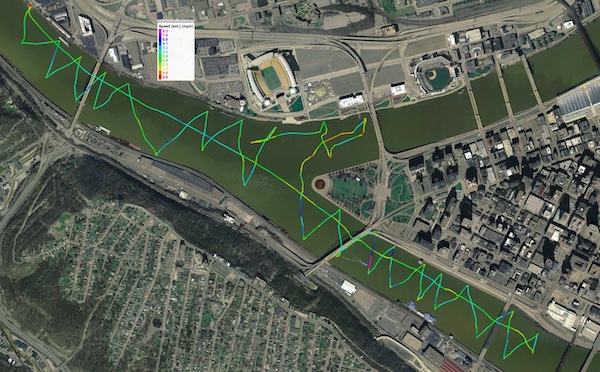 click for larger
click for larger